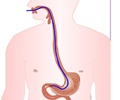What are the Symptoms and Signs of Whipple’s disease?
The predominant symptoms of Whipple’s disease are due to disease of the intestines.
Whipple’s disease affects multiple organs, but the most predominant symptoms are due to involvement of the small intestines. The most common symptoms when the patient first visits the doctor are weight loss, diarrhea and pain in multiple joints.
Symptoms and signs of Whipple’s disease include-
- Low-grade fever, which may be the only symptom for several years
- Enlargement of lymph nodes
- Digestive tract symptoms and symptoms due to problems with absorption of nutrients. These include:
- Weight loss, diarrhea and abdominal pain
- Bulky, greasy and foul smelling stools which are difficult to flush, and leave a film of oil in the toilet pan after flushing. This is due to the reduced absorption of fat in the intestines
- Accumulation of fluid and swelling in the limbs and abdomen due to reduced protein content of the body
- Anemia due to reduced absorption of iron and folate from the intestines
- Bleeding and clotting problems due to reduced absorption of vitamin K
- Fragile bones due to decreased absorption of vitamin D
- Loss of appetite or excessive gas formation
- A mass may be present in the abdomen due to swelling of lymph nodes, spleen or abnormal intestines
- Pain or inflammation of the joints may precede other symptoms by several years. It lasts for a few days to weeks, followed by long periods or remission
- Cardiac symptoms due to inflammation of the various parts of the heart including the heart valves; disease of the heart may result in heart failure
- Symptoms due to affliction of the nervous system like headaches, confusion, coma, seizures, swaying gait, psychiatric symptoms, forgetfulness, paralysis of eye muscles, muscle jerking, hearing loss, increased thirst and urination, increased eating, and altered sleep pattern. A unique feature is the occurrence of slow, smooth pendular movement of the eyes with synchronous contractions of the jaw. This is called oculomasticatory myorhythmia. These eye movements are also associated with synchronous contractions of other body parts, where it is referred to as oculofacial-skeletal myorhythmia. Symptoms of meningitis may also be present
- Eye symptoms are either due to direct eye involvement or due to involvement of the brain areas that control eye movement, as explained above. Inflammation of the eye and glaucoma may be present
- Darkened skin patches on the exposed part of the skin and small nodules below the skin
- Chronic cough with chest pain due to involvement of the lungs and surrounding structures






